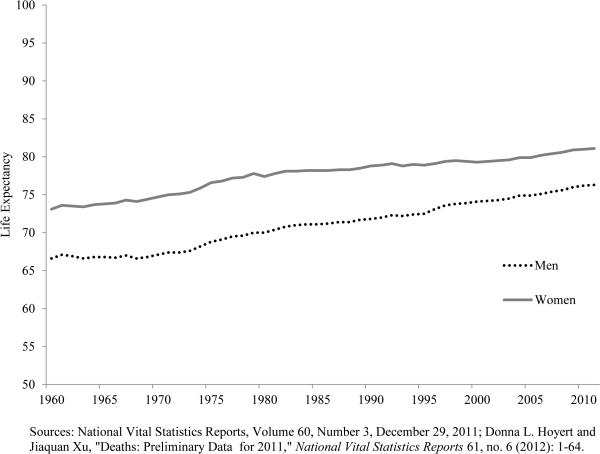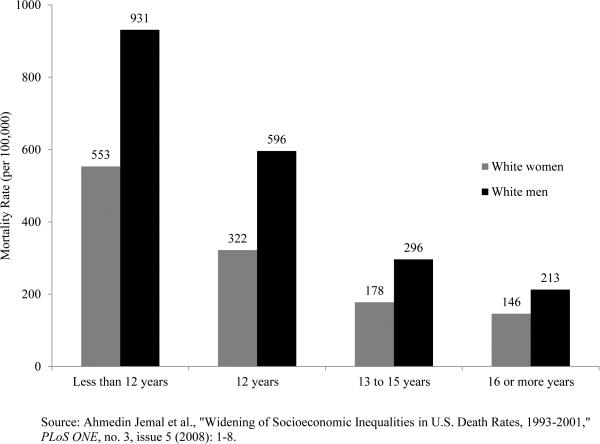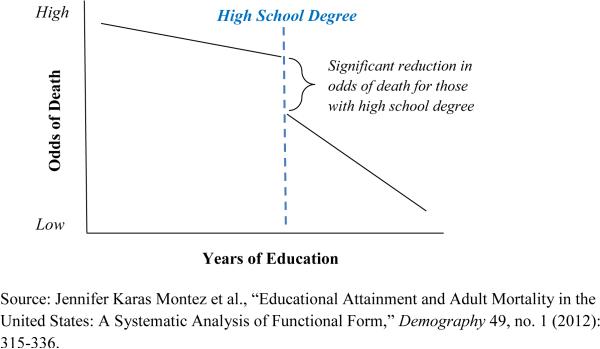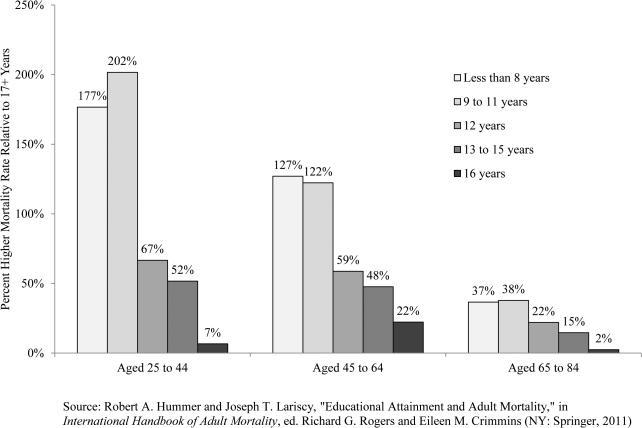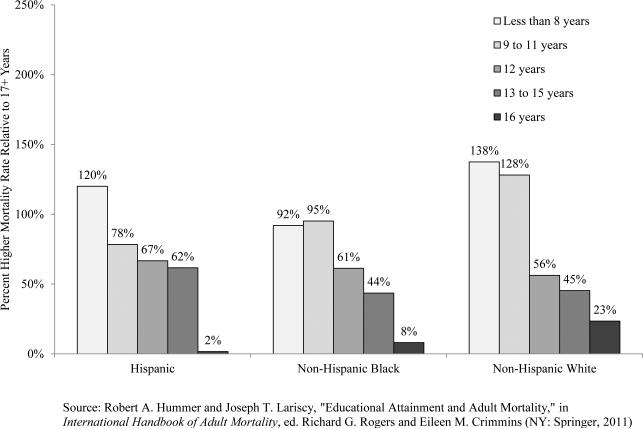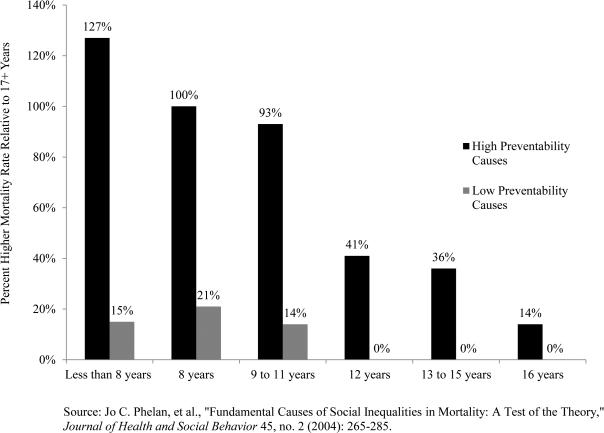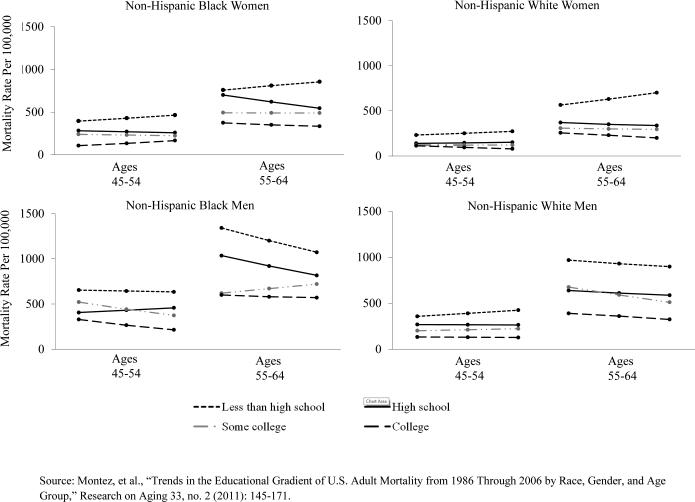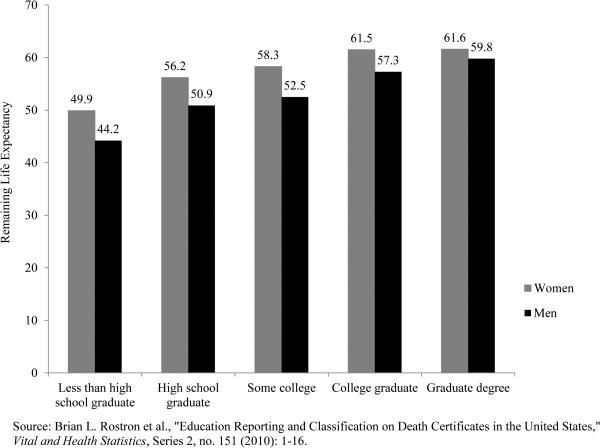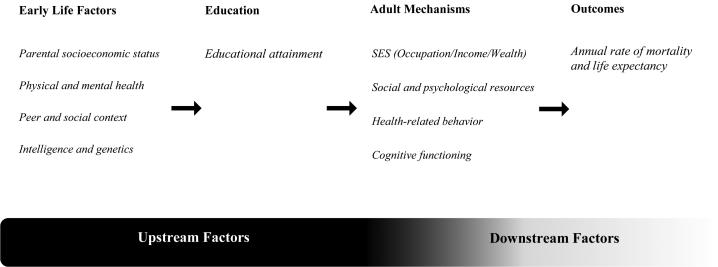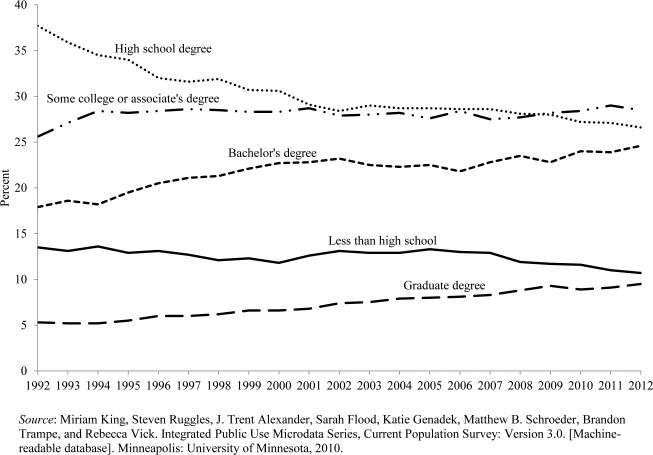In 2011, U.S. mortality rates reached record lows for both women and men; as a result, life expectancy at birth reached record highs: 81 years for women and 76 years for men.1 These are impressive figures. As recently as 1960, women's life expectancy at birth was only 73.1 years and men's only 66.6 years.2 Within 50 years, life expectancy at birth increased by 8 years for women and nearly 10 years for men (see Figure 1).
Figure 1.
US Life Expectancy at Birth by Gender, 1960-2011
Unfortunately, these increases in life expectancy mask very wide disparities among population groups. For example, remaining life expectancy at age 25—an important overall indicator of adult population health—is about a decade shorter for people who do not have a high school degree compared with those who have completed college.3 Educational attainment appears to be very important in differentiating U.S. adults’ prospects for long life.
These differences represent critical health and social issues with important implications for policymakers. Because well-educated individuals have a much longer life expectancy, is such an accomplishment (or at least a substantial improvement) possible for other subgroups? The potential to reduce these educational differences in mortality and life expectancy underscores the need to accurately describe them and understand why they exist. Armed with such information, policymakers then have the evidence to ensure that U.S. adults are sufficiently educated so that no group pays a “longevity penalty.”
Despite the potential to reduce educational differences in mortality, it may be overly simplistic to assume that they are easily responsive to increased future investments in the education of U.S. children. Higher levels of schooling do not necessarily cause people to live longer. Other factors, such as parental education and income, may be related to both high educational attainment and longevity among U.S. adults. If so, then even the best-intentioned policy efforts to reduce educational differences in mortality may be of little value. In short, this area of scientific inquiry and policy interest is controversial.
In this Population Bulletin, we examine educational differences in U.S. adult mortality and life expectancy. We provide a balanced and up-to-date portrait of the key results and implications of research in this area. We address five major issues: What is the current association between educational attainment and adult mortality? Have educational differences in adult mortality changed over the past 50 years? Why do such wide educational differences in adult mortality now exist? What are the policy implications of recent education-mortality research? And what are the implications of recent work in this area for future education-mortality research?
A HEAD: Educational Differences in Adult Mortality
Highly educated adults in the United States have lower yearly mortality rates than less-educated people in every age, gender, and racial/ethnic subgroup of the population.
The most common method of documenting annual mortality rate differences by educational attainment is to divide the adult population over age 25 into three or four educational attainment categories and then calculate mortality rates for each of them. The most typical categories include individuals who have:
Less than a high school degree or its equivalent.
A high school degree or its equivalent.
Some college but not a bachelor's degree
A bachelor's degree or higher.
Such documentation is usually based on official U.S. mortality data from a single year. Data on the number of people who died within each educational category is derived from death certificates and serves as the numerator for the mortality rates, while the total number of people in each category comes from census-based counts or estimates and serves as the denominator.
U.S. data for adults ages 25 to 64 shows wide variation in mortality rates by educational attainment for both white women and men (see Figure 2).4 The mortality rate for white women who have not completed high school is nearly four times higher than the rate for white women with 16 or more years of education. An even wider disparity is evident for the same categories of white men: Men with less than a high school degree have a mortality rate more than four times higher than those who have completed at least 16 years of education. Individuals who have only completed high school or some college display mortality rates in between those with the highest and lowest levels of educational attainment. Thus, each increase in educational attainment is associated with a lower mortality rate for both white women and men.
Figure 2.
Mortality Rates for US Adults Ages 25-64 by Educational Attainment, 2001
Although useful for a basic understanding of educational differences in adult mortality, this description presents two problems. First, education level is often reported inaccurately on U.S. death certificates. The most common error occurs when educational attainment is reported as 12 years (high school graduation) when, in fact, the deceased person did not complete high school.5 Second, using only three or four educational attainment categories could fail to capture even wider education-mortality differences among subgroups of the population. For example, individuals who earned professional or graduate degrees (master's degrees, law degrees, medical degrees, or doctoral degrees) may have even lower mortality rates than individuals whose highest educational level is a bachelor's degree.
To overcome the inaccurate reporting of educational level, researchers have increasingly relied on data from national surveys of U.S. adults rather than death certificate- and census-based official mortality data. Survey-based mortality data sets use self-reports of respondents’ own educational attainment (and other social-demographic characteristics), and respondents are then followed for many years to determine who lives and who dies over the subsequent follow-up period. To address the limitation of too few educational categories, researchers have increasingly specified a larger number of attainment categories.
By using survey-based mortality data sets and more extensive measurement schemes of educational attainment, several recent studies have shown that educational differences in adult mortality are even wider than typically documented using the standard approach. As an example, U.S. adults who have master's, doctoral, or professional degrees—a growing subgroup of American adults—have been shown to exhibit even lower mortality rates than those who have bachelor's degrees.6
But the association between educational attainment and adult mortality may be even more complex. In an important recent paper, Jennifer Montez and colleagues recently assessed whether standard educational categories or a different way to measure educational attainment best predicted the odds of U.S. adults dying over a 20-year period following their inclusion in a major U.S. survey.7 For both women and men, they found that the most accurate depiction of the relationship between educational attainment and the odds of adult mortality included three components: a slight linear decline in the odds of mortality as educational attainment increased from 0 to 11 years, a significant reduction in the odds of mortality for adults who obtained a high school degree, and a steep linear decline in the odds of mortality as educational attainment increased beyond high school degree (see Figure 3). Thus, obtaining a high school degree is very important for lowering the yearly odds of mortality among U.S. adults; moreover, the declines in mortality above the high school degree level are even steeper.
Figure 3.
Relationship between Educational Attainment and Mortality for US Adults
B HEAD: AGE, GENDER, AND RACE
Educational differences in adult mortality are wide in every age, gender, and racial/ethnic group in the United States. Nonetheless, there are some variations that suggest educational attainment may be operating somewhat differently across population subgroups to influence adult mortality. First, educational differences in mortality are wider among younger adults compared with older adults. A recent study using a nationally representative survey of U.S. adults found that women ages 25 to 44 with nine to 11 years of schooling had a 202 percent higher mortality rate over a 16-year follow-up period than similarly aged women who had completed at least 17 years of education (see Figure 4).8 Among women ages 65 to 84, mortality was 38 percent higher among the group with nine to 11 years of education compared with those who had 17 or more years of education. At the same time, because mortality rates are far higher in older adulthood than in younger adulthood, even relatively small mortality differences by educational attainment in older adulthood are meaningful because of the heavy concentration of deaths in older ages.
Figure 4.
Mortality Rate Differences Relative to Persons with 17+ Years of Education, U.S. Women by Age
Recent studies also show that educational differences in U.S. adult mortality are somewhat wider among men than women (see Figure 2). In particular, less-educated men have especially high mortality rates from causes such as lung cancer, respiratory diseases, accidents, and homicide. In contrast, men with high levels of education not only have much lower mortality rates than less-educated men, but they also have mortality rates that are not too much higher than those of highly educated women.9 Clearly, high educational attainment helps men close the gender mortality gap with women; but at the same time, less-educated men have mortality rates far higher than those of less-educated women.
Finally, educational differences in mortality are wider among U.S. white adults than among either black or Hispanic adults. Highly educated whites have far lower mortality rates and longer life expectancies than whites with low levels of education. Although highly educated black and Hispanic adults also have lower mortality rates than their less-educated counterparts, compared to whites the “high education payoff” does not seem to be as strong among these minority groups (see Figure 5).10 One possible reason is that blacks and Hispanics are more likely to attend and graduate from lower-quality high schools and colleges compared with whites, and may not reap the same health and longevity benefits from their education as whites. In addition, black and Hispanic adults, even those with high education, encounter discrimination in various forms and contexts throughout their lives that affects their prospects for longevity.
Figure 5.
Mortality Rate Differences Relative to Persons with 17+ Years of Education, U.S. Women by Race/Ethnicity
B HEAD: CAUSE-SPECIFIC MORTALITY
A number of recent studies have found that educational differences in mortality vary across causes of death. For example, deaths that are more closely linked to social and behavioral risk factors (lung cancer, respiratory diseases, homicide, and accidents) are associated with wide educational differences in mortality rates, while there are narrower educational differences in mortality rates for causes less amenable to human control (such as cancers other than lung cancer).11
In an innovative analysis, Jo Phelan and colleagues rated the preventability of causes of death.12 Causes such as lung cancer, homicide, and most forms of accidents were rated as highly preventable, while causes such as multiple sclerosis and cancer of the gallbladder were rated as having low preventability because there is little scientific knowledge about how to prevent or treat them. Phelan and colleagues found that U.S. adults ages 45 to 64 with nine to 11 years of education had a 93 percent higher mortality rate than individuals with 17 or more years of schooling for highly preventable causes of death (see Figure 6). For causes that were not very preventable, similarly aged adults with nine to 11 years of education had just a 14 percent higher mortality rate compared with persons who had 17 or more years of education. Thus, educational attainment is most closely associated with mortality rates for causes under greater human control. However, for all major causes of death, highly educated persons die at lower rates than persons with lower levels of education.
Figure 6.
Mortality Rate Differences Relative to Persons with 17+ Years of Education, U.S. Women Ages 45-64, by Preventability of Cause
A HEAD: Over The Last 50 Years
In the early 1970s, Evelyn Kitagawa and Philip Hauser published a path-breaking study of educational attainment and adult mortality in the United States.13 Using data from 1960, they compared remaining life expectancy at age 25 for white females and males by educational attainment. Men who had completed high school but no higher were expected to live up to two years longer than less educated men and about one year less than men who had completed at least one year of college. Women's life expectancy differences were somewhat wider at the time: women who had completed at least one year of college were expected to live about four years longer than women who had only completed high school and up to nine years longer than the lowest educated women.
Levels of educational attainment in U.S. society have risen substantially since this landmark study, and scholars have amassed a large body of scientific research examining trends in educational differences in adult mortality rates and life expectancy since that time. Samuel Preston and Irma Elo found that educational differences in mortality widened for all adult men between 1960 and the late 1980s, but narrowed for women between ages 25 to 64. For women who were ages 65 or older, educational differences in mortality remained similar to those found by Kitagawa and Hauser.14
Over the past five years, a number of studies have used data from the late-1980s through the late 2000s to examine trends in the association between educational attainment and adult mortality.15 Even with a variety of data sets and methodological approaches, all arrived at the same general and important conclusion: Educational differences in mortality and life expectancy have widened over the past 20 to 25 years. In fact, age-specific mortality rates among black and white women who did not complete high school actually increased over the past two decades. Moreover, the pace of mortality decline has been steepest among highly educated individuals in most age-sex-race demographic groups (see Figure 7).
Figure 7.
Trends in death rates for non-Hispanic Black women/men and non-Hispanic White women/men across three time periods (1986-1992, 1993-1999, 2000-2006) by educational attainment and age group.
Ryan Masters and colleagues further established that these growing educational differences in adult mortality depended on birth cohort—a group of people born during the same time period.16 They found that by solely studying these trends on a year-to-year basis, researchers are missing an important piece of the puzzle: Educational-mortality differences are actually growing wider by birth cohort. In other words, educational attainment is playing a more prominent role as a differentiator of mortality rates for younger cohorts of Americans. This cohort-based widening of educational differences in mortality is important for two reasons. First, these results indicate that highly educated adults in more recent birth cohorts are better positioned and equipped than ever before to live long lives. Second, this pattern strongly suggests that policymakers should devote increasing attention to the educational opportunities and trajectories of very recent birth cohorts of Americans, given the strengthening relationship between educational attainment and adult mortality as new cohorts move into adulthood.
This body of research documenting trends in educational differences in mortality since 1960 has demonstrated that educational attainment has become a very strong differentiator of men's mortality and longevity over the past 50 years. And more recent evidence clearly points to widening educational differences in mortality for women as well. Given these widening differences over the past few decades, Brian Rostron and colleagues recently used mortality rates from 2005 to develop new estimates of remaining life expectancy at age 25 in a number of U.S. states (see Figure 8).17 Their estimates suggest very wide contemporary educational differences in remaining life expectancy for both U.S. women and men, likely the widest in history. At age 25, women with less than a high school degree were estimated to live an average of 50 additional years, while women with a graduate or professional degree were estimated to live 62 additional years—a difference of 12 years. The gap was even wider for men: Men with less than a high school degree were estimated to live an additional 44 years on average, but men with a graduate or professional degree were expected to live an additional 60 years—a difference of 16 years.
Figure 8.
Remaining Life Expectancy for US Adults at Age 25 by Educational Attainment, 2005
A HEAD: Reasons for the Differences
It is challenging to meticulously document educational differences in adult mortality; key limitations exist in the literature. For example, the scientific community knows almost nothing about the association between quality or content of education and mortality. But the results in the previous section do provide solid evidence, from multiple data sources, that current educational differences in U.S. adult mortality are probably the widest in America's history. Why then is educational attainment so strongly related to mortality and life expectancy today?
Researchers would need a tremendous amount of high-quality data to fully unpack why educational attainment is so strongly associated with mortality and longevity. To start, researchers would need to know why some individuals receive graduate degrees while others never finish high school (i.e., reasons could include family background, genetics, childhood health conditions, and key teachers and peers, among others); where individuals attended school; what they learned; how their basic skills developed; and who else attended the same school. Beyond these requirements, researchers would also need to know how individuals’ educational attainment is associated with a variety of other economic and social characteristics throughout the life course, such as occupational status, income, patterns of family formation, and access to health care. Adding complexity, researchers would require information about these factors for multiple time intervals.
Despite these immense challenges, scholars have made progress explaining the strong relationship between educational attainment and adult mortality, especially in three areas: understanding whether education is causally linked with mortality, understanding the role of educational attainment as a key resource over the life course, and understanding mechanisms that link higher educational attainment to lower rates of mortality and greater longevity.
B HEAD: IS EDUCATIONAL ATTAINMENT CAUSALLY LINKED WITH MORTALITY?
In attempting to understand whether education and mortality are causally linked, researchers think carefully about alternative explanations: Is educational attainment related to mortality and longevity because common factors influence both? Are there common factors that lead to their association, making it a correlation rather than a causal relationship? Consider the factors presented on the far left side of Figure 9 depicting the relationship between educational attainment and adult mortality. People who grow up with parents with low levels of education and/or those who come from impoverished families are more inclined to have poor physical and mental health early in life, as well as a higher chance of negative peer influences during adolescence. They may end up completing fewer years of education and have higher annual risks of mortality than people who have not faced such hardships. These factors related to early life hardships may be at the root of some educational differences in adult mortality.
Figure 9.
Conceptual Diagram Linking Educational Attainment to Adult Mortality and Life Expectancy
An innovative study recently conducted by Jere Behrman and colleagues challenges the notion that higher educational attainment causes people to have lower levels of mortality and a longer life expectancy.18 The study used a unique data set that included pairs of twins, both identical and fraternal, as well as unrelated adults to examine educational differences in adult mortality in Denmark. The benefit of twin data, particularly information from identical twins, is that these pairs of individuals have identical genes and very similar social and environmental backgrounds. Behrman and colleagues were thus able to determine whether there were educational differences in adult mortality among both unrelated adults and among twins in Denmark.
Interestingly, among identical twin pairs with different education levels, they found only weak evidence of a relationship between educational attainment and adult mortality. They did find stronger evidence that educational attainment is associated with mortality among fraternal twin pairs as well as unrelated individuals—but those two groups of people differed more than identical twins with respect to genetic backgrounds and childhood social environments. This research suggests that educational attainment may not have a strong causal relationship with adult mortality in Denmark, at least for the birth cohorts included in the study (people born between 1921 and 1950). But the association between education and adult mortality in Denmark may be quite different from the United States, where educational differences in mortality have clearly widened in recent decades.
Unfortunately, there are no twin-based data sets of sufficient size to conduct a similar mortality analysis in the United States. However, researchers using U.S. data are beginning to take into account some of the background factors that may affect the association between educational attainment and adult mortality. One innovative study by Jennifer Montez and Mark Hayward combined survey measures of educational attainment with a broad set of childhood socioeconomic and health characteristics to predict mortality over a 10-year period for U.S. individuals ages 50 and above.19 Even after accounting for childhood socioeconomic and health characteristics, they found a very strong association between educational attainment and mortality for both women and men. In a related study, Bruce Link and colleagues found that the association between individuals’ educational attainment and mortality remained largely unchanged when differences in intelligence were taken into account. 20 In sum, the majority of recent evidence that focuses on the U.S. context supports the idea that educational attainment and mortality are strongly related even after accounting for the kinds of background factors depicted in Figure 9.
Determining whether educational attainment is causally related to mortality requires specific data and careful analysis that is statistically complex, but it will remain a very important objective for researchers and policymakers in the coming decades. Understanding the causal impact of educational attainment on adult mortality is important in order to design the most effective social and health policies related to educational attainment. Although the Denmark study by Behrman and colleagues casts at least some doubt on the causal impact of educational attainment on mortality, the best evidence to date from the United States suggests that the education-mortality association is predominantly causal.21
B HEAD: THE CENTRAL ROLE OF EDUCATION IN THE LIFE COURSE
From a practical research perspective, educational attainment is the easiest dimension of socioeconomic status to assess on social and health surveys. But other dimensions of socioeconomic status, such as occupational status, income, and wealth, are also strongly associated with mortality and longevity in the United States and many other countries. While our earlier discussion mentioned problems with misreporting of educational attainment data on death certificates, educational attainment is reported well on the social and health surveys often used to analyze U.S. adult mortality.22 Even more, unlike occupational status, income, and wealth, educational attainment often remains constant throughout much of adult life. Indeed, educational attainment is less prone to downturns in a person's health than the other dimensions of socioeconomic status. Educational attainment provides a more concrete focus for policymakers than socioeconomic status: If educational attainment is shown to affect mortality and life expectancy, then increased educational investments can be made. In contrast, a research focus on a multidimensional concept such as socioeconomic status may result in murky policy recommendations: Is it straightforward, for example, to increase individuals’ socioeconomic status?
Sociologists who have researched socioeconomic status and health even note that “education creates most of the association between higher socioeconomic status and better health because education is a root cause of good health.”23 Furthermore, educational attainment does not simply influence mortality through the other dimensions of socioeconomic status; it influences many other aspects of the life course as well, including health-related behavior, access to health care, cognitive functioning, and the development of social and psychological resources.
Building on the idea that education—and other measures of socioeconomic status— is a root cause of good health, Bruce Link and Jo Phelan have developed “fundamental cause theory” to explain the enduring impact of educational attainment on health and longevity.24 They propose that educational attainment is a root or primary cause of health and longevity because: a) it affects multiple diseases, b) it works through multiple mechanisms to influence health and longevity, c) it is a resource that can be used to avoid health risks or lessen the impacts of disease once it occurs, and d) it continues to influence health and longevity even when the mechanisms linking it to health and longevity change. Lending support to this idea, Richard Miech and colleagues recently showed that educational differences in adult mortality widened over the past 10 years largely because educational attainment was so strongly associated with causes of death that became more prevalent in U.S. society over this time period.25 For example, deaths due to accidental poisoning (such as drug overdoses) increased significantly in the US over the last 10 years, and were especially pronounced among people with low levels of education.
B HEAD: MECHANISMS LINKING INCREASED EDUCATIONAL ATTAINMENT TO LOWER MORTALITY
Figure 9 shows four interrelated mechanisms by which educational attainment is related to adult mortality. Keep in mind, however, that Link and Phelan's fundamental cause theory stresses that the impact of such mechanisms may change over time and differ across places; moreover, mechanisms may differ to some degree across population subgroups. Nonetheless, most recent empirical work in this area stresses these mechanisms as the most important ways by which educational attainment is currently linked to adult mortality in the United States.
Socioeconomic attainment—occupational status, income, and wealth—is an important mechanism. Recent estimates based on empirical work from two independent research groups suggest that higher socioeconomic status among highly educated individuals accounts for 30 percent to 40 percent of the mortality difference between individuals with the highest and lowest levels of education in the United States.26 In particular, increased income improves health-related lifestyles, affords individuals the chance to live in better housing located in safer neighborhoods, and enhances individuals’ access to higher-quality food. Moreover, higher occupational status and income also help U.S. individuals acquire comprehensive health insurance plans, which is important for accessing high quality health care on both routine and emergency bases.
Health behaviors may account for another 30 percent of the mortality difference between individuals with high and low levels of education. For instance, smoking rates vary prominently by education level. Justin Denney and colleagues recently showed that much higher rates of cigarette smoking among less-educated middle-aged adults are especially important in differentiating their mortality rates from those of highly educated persons in the same age range.27 While cigarette smoking has become much less common among all U.S. adults in recent years, it remains much more prevalent among the less educated than among the highly educated. If this pattern holds, individuals with less education will continue to have much higher rates of lung cancer, respiratory diseases, heart disease, and other smoking-related causes of death. But other health behaviors—such as exercise, nutrition, alcohol and other drug use, use of home safety devices such as smoke alarms, and preventive health care are all related to educational attainment and may help to account for higher mortality rates among those who have less education.28 Notably, education-related differences in health behaviors are wide both for behaviors that are low or no cost, as well as for those that are expensive.
An expanding area of research also suggests that higher educational attainment may be associated with lower mortality because of the beneficial social ties enjoyed by highly educated individuals. Highly educated individuals are more likely to have highly educated spouses, friends, neighbors, and co-workers who can help them when needed. Dustin Brown and colleagues recently showed, for example, that married U.S. adults who have highly educated spouses have better health than married adults who have lower-educated spouses.29 But social ties of highly educated people may also be important even if they are relatively weak—for example, a neighbor who is a physician may offer critical health advice in a time of need. While difficult to measure, recent estimates suggest that these social ties may account for 10 percent to 15 percent of educational differences in adult mortality.
Finally, cognitive functioning is an important mechanism for education differences in U.S. adult mortality. And some researchers propose that it is the most critical mechanism responsible for education differences in mortality. David Baker and colleagues recently proposed that the formal process of learning is the key way that educational attainment has become so strongly related to adult mortality in the U.S.30 After all, children, adolescents, and young adults spend a great deal of time in school, learn to read and write in successively complex manners, learn to evaluate risks, and learn to process information and make decisions that enhance health and longevity. Baker and colleagues also offered intriguing evidence that it is not simply the case that individuals with high intelligence achieve more years of schooling and live longer. Rather, educational attainment is the primary tool by which individuals develop high-order cognitive skills and then use those skills to live healthy and long lives.
A HEAD: Policy Implications
Many policies designed to improve mortality rates and life expectancy target specific risk factors or mechanisms. Anti-smoking policies are a prime example. A multitude of public health policies have been implemented to reduce tobacco use and exposure to smoke, ranging from taxing tobacco products to banning smoking in restaurants and bars to requiring warning labels on products. Such policies reflect an effort to intervene on downstream risk factors (or what we call mechanisms)—those that are closely tied to the specific health problem or cause of death in question. Yet, after the U.S. Surgeon General published an official warning about the dangers of smoking in 1964, an interesting pattern emerged. Smoking rates declined significantly among individuals who had completed higher levels of education, but these rates were much slower to decline among less-educated individuals. These differential declines have resulted in an educational gradient in smoking that is now quite wide. Such educational differences in smoking declines thus lead to another question: Is it possible to intervene on upstream factors—those that are associated with (or may precede) many risk factors?
Educational attainment represents one such possible upstream factor. As this Population Bulletin has described, individuals in the United States who are more highly educated live longer lives, on average, and strong evidence suggests that educational attainment serves as a fundamental cause of health and life expectancy.31 The previous section outlines a number of mechanisms through which educational attainment influences mortality and longevity. From this perspective, we propose that educational attainment constitutes an upstream factor that is associated with a range of downstream risk factors or mechanisms that affect health and ultimately longevity. By extending the purview of health policy to include such upstream factors, we join other demographers, economists, and sociologists who have recently contended that investments in social policy are also investments in health policy.32
B HEAD: SOCIAL POLICY AS HEALTH POLICY
Policies designed to increase social and/or economic well-being are generally thought to be unrelated to health and longevity. However, as we have described, social science and epidemiological research has increasingly pointed to education as an upstream factor associated with exposure to a variety of factors associated with mortality rates and life expectancy. Thus, a growing body of evidence suggests that enhanced investments in education at the population level may also double as investments in the long-term health and longevity of the population.
One approach to conceptualizing a social or upstream policy as a health policy is to consider the parable of a physician rescuing people from a river:
“There I am standing by the shore of a swiftly flowing river and I hear the cry of a drowning man. So I jump into the river, put my arms around him, pull him to shore and apply artificial respiration. Just when he begins to breathe, there is another cry for help. So I jump into the river, reach him, pull him to shore, apply artificial respiration, and then just as he begins to breathe, another cry for help. So back in the river again, reaching, pulling, applying, breathing, and then another yell. Again and again, without end, goes the sequence. You know, I am so busy jumping in, pulling them to shore, applying artificial respiration, that I have no time to see who... is upstream pushing them all in.” 33
By directing energy downstream, targeted health efforts often fall short of addressing the root of the problem, the reason why people are in the river in the first place. Enhanced policy efforts that resuscitate more and more people after they fall into the river is an example of a downstream health policy, whereas enhanced efforts to prevent people from ending up in the river in the first place represents an example of an upstream social policy. In the latter case, a social policy that prevents people from ending up in the river also serves as a health policy because it would indirectly affect the health and longevity of the population. In the case of educational differences in adult mortality, enhanced investments in the early educational progress of American students helps ensure that they will complete high school and perhaps even pursue a higher degree. With at least a high school degree, such individuals may also experience better life-long employment opportunities, have enhanced cognitive skills, and have relationships with others who are more highly educated. These examples represent mechanisms by which individuals can make more informed health-related decisions and potentially live healthier and longer lives.
B HEAD: ENHANCING POPULATION HEALTH BY INVESTING IN EDUCATION
Understanding the potential mortality and life expectancy implications of education policy presents a number of challenges. First, what are the costs and potential mortality and longevity returns of enhanced investments in education? There are no clear answers to this question.
One recent study made an interesting comparison. Steven Woolf and colleagues estimated whether more lives would have been saved between 1996 and 2002 by equalizing levels of educational attainment so that all U.S. adults would have at least a college degree compared to the number of lives saved from advances in biomedicine over this time period.34 Their estimates indicated that many more lives would have been saved from increasing education levels than from advances in biomedicine. This specific example is not intended to promote a reduction in such medical or public health advances, but rather to highlight the enormous potential importance of educational attainment for population health.
Another ad-hoc way to determine the value of enhanced investments in education is to quantify, in monetary terms, how much an additional year of education would be worth for each person in the country. Assuming that each additional year of life is worth $75,000, David Cutler and Adriana Lleras-Muney estimated that each additional year of education would be worth somewhere between $13,500 and $44,000 per person, given the very strong association between educational attainment and U.S. adult mortality. On a national scale, this would translate into a very large amount of money.35 It is important to note that these types of estimates account solely for the length of life—or the value of an additional year of life—but they exclude the potential impacts that additional years of education may have on quality of life. If we were to account for improvements in quality of life as well, the value of each additional year of education would be even higher.
Even though educational attainment in the United States has continued to increase over the last two decades, a significant proportion of the young adult population has still not graduated from high school. As of 2012, 10.7 percent of non-institutionalized U.S. young adults ages 25 to 34 had not graduated from high school (or its equivalent), and an additional 26.6 percent had only attained a high school degree (see Figure 10). Moreover, another 28.5 percent of young adults had completed some college or an associate's degree, but not obtained a bachelor's degree. Taken together, nearly two-thirds (65.8 percent) of adults ages 25 to 34 in the United States have less than a bachelor's degree.36 These data indicate that there is still considerable room for improvement in the educational attainment of young adults in the United States, which could, in turn, have a significant impact on the future mortality rates and longevity patterns of the U.S. population. Moreover, the two largest U.S. minority groups, Hispanics and African Americans, continue to have lower high school and college completion rates than the majority white population. In turn, policies aggressively targeted toward the high school completion rates of minority populations could additionally have the long-term benefit of reducing racial/ethnic disparities in health and mortality outcomes as well.
Figure 10.
Educational Attainment among Non-Institutionalized US Adults Ages 25-34, 1992-2012
A more specific approach to designing educational policy that is effective for enhancing longevity involves understanding the nuanced association between various levels of educational attainment and adult mortality rates. As illustrated in Figure 3, recent research by Jennifer Montez and colleagues shows that there is a steep reduction in mortality rates for American adults who receive a high school degree in comparison to those who do not.37 Thus, a very reasonable first step in designing an effective education policy for reducing U.S. adult mortality and enhancing longevity would clearly focus on substantially reducing the high drop-out rate. Such a policy might be especially important both because educational differences in mortality are widening for younger cohorts and because more than 10 percent of U.S. young adults continue to have less than a high school degree.
An important consideration and challenge in designing education policy as health policy is the lag between the intervention and the desired population-based outcome. Although educational policy presents an important opportunity to intervene, the health and longevity benefits may not occur for years, and likely decades. Thus, any serious attempt to design education policy as health policy is an investment in the health and longevity of the population on a long term basis. Although this lag presents challenges, such investments in both education (directly) and health (indirectly) are likely to have a ripple effect across networks of individuals, and potentially through communities. Indeed, an increasing body of evidence points to the important role of social ties in influencing health behaviors and health, and thus longevity.38 Obvious ties include parent-child and spousal relationships, but investments in education to improve health may also expand beyond direct familial ties to other network members, such as work colleagues, neighbors, and friends.
Any policy designed to improve health and longevity by increasing investments in education also needs to account for the different ways that education operates for subgroups within the population. Though beneficial, additional education is not associated with precisely the same mortality and longevity outcomes for people belonging to different race/ethnic, gender, or age groups. Although this should not dissuade policymakers from considering investments in education policy as health policy, it is important to remember that educational investments may have different effects on mortality and longevity for particular groups.
B HEAD: TARGETING DIFFERENTIALS VS. IMPROVING OVERALL POPULATION HEALTH
Although a number of important questions remain about the relationship between educational attainment and adult mortality, researchers from a variety of fields agree that higher levels of education are associated with lower U.S. adult mortality rates and that this relationship is strengthening. These central findings raise two important questions for policymakers who intend to further invest in education to improve population-level health: Will the policy target educational differences in mortality and life expectancy? Or will the policy be designed to generally improve education levels and, thus, population health for everyone? We refer to these two policy alternatives as “disparity policies” and “population improvement policies,” respectively.
Disparity policies are akin to public health policies designed to target individuals at a high-risk of developing a disease or illness.39 In this public health strategy, researchers determine the distribution of a measurable risk factor within a population—for example, cholesterol levels— and then set a value above which individuals are at a high risk of developing health problems. An intervention or policy is then designed to improve cholesterol levels by targeting individuals in the high-risk category. If successful, the direct result of decreasing cholesterol levels among those above the high-risk threshold is that the difference between the highest and lowest cholesterol levels declines. Analogously, an education disparity policy would focus on reducing/eliminating the educational category with the highest level of mortality (i.e., less than a high school degree). Given that U.S. adults with less than a high school education have by far the highest levels of adult mortality and shortest life expectancies (see Figure 3 and Figure 8, respectively), such a disparity policy is well worth considering in the current U.S. context.
Yet, there are two important caveats to remember. First, it is important to remember that disparity policies solely target the reduction/elimination of low levels of education, and do not focus on improvements at higher level of schooling. And second, it is impossible to guarantee that raising high school graduation rates necessarily would reduce future mortality rates. Consider, for example, that population-level changes to the distribution of educational degrees would likely alter requirements to enter the labor market; that is, employers may require additional degrees before they hire individuals. Even so, as we have described in this Bulletin, the experience of being in school improves individuals’ ability to acquire, decipher, and act upon health information over their entire life course when they are healthy or sick, enabling them to make healthier decisions and live healthier and longer lives.40 Thus, even with uncertainties regarding how the labor market would react to higher high school completion rates, increased high school completion rates would most likely yield health and longevity benefits for the segment of the population that has increasingly fallen behind the rest of the population.
In contrast to disparity policies, population improvement policies aim to benefit the entire population. A similar public health strategy, the “population strategy,” involves designing interventions to shift the entire distribution of a specific risk factor.41 Using the example of cholesterol levels, a population strategy would involve lowering cholesterol levels among everyone, not just among those in the high-risk category. An analogous education policy would aim to increase education levels among the entire population, not just high school completion. As opposed to disparity policies, this approach shifts the entire distribution upward. Such a distributional shift would be very small for each individual, but by aiming to change the entire population, the objective would be to provide an overall population health improvement. Again, similar caveats apply to this approach. Although it does aim to improve education among the entire population, it does nothing to specifically reduce educational disparities in mortality. Moreover, it is difficult to predict how such a population-level shift would alter mortality rates over time.
Designing the best education policy as health policy requires careful consideration of these two approaches because each provides benefits and drawbacks for improving population health.
A HEAD: Conclusion
Scientific understanding of educational differences in U.S. adult mortality has increased substantially over the past few decades. Following Kitagawa and Hauser's path-breaking study in the early 1970s, more recent research has helped us identify important trends in the education-mortality relationship and understand how they vary across race/ethnicity, gender, and age. Perhaps most important, it is clear that educational differences in both mortality rates and life expectancy have widened over the past several decades. Presently, the mortality and life expectancy gaps between U.S. adults with the highest and lowest levels of schooling are most likely wider than ever. Moreover, a sizable share of U.S. adults continues to have less than a high school education or completes high school but no secondary education; these millions of individuals will be at higher risk of death on an annual basis in the coming decades compared to their more highly educated counterparts. There is little question that there is significant room for improvement by enhancing U.S. population health through increases in educational attainment, particularly for the sizable number of individuals who do not complete a high school degree.
Research Recommendations.
Despite making significant strides in the study of educational attainment and adult mortality, the scientific community's understanding of this complex relationship is far from complete. Addressing the limitations of previous research through carefully designed studies will not only facilitate a more accurate depiction of the relationship, it will provide the best information possible to help policymakers thoughtfully design education policy as health policy. The following subsections present two key challenges for future researchers aiming to study the education-mortality relationship.
Incorporating Complexity in the Educational Process
Future studies relating educational attainment to adult mortality need to consider the substantial complexity that characterizes the educational process. This is not a simple task, particularly in a context of rapid social change and during an era characterized by diversifying educational experiences and types of schools. Key questions include, but are not limited to, the following: 1) Why do some individuals obtain high levels of education while others obtain low levels? Put another way, how do family background, influential teachers, peer effects, school characteristics, educational policies, and innate ability influence educational attainment? 2) Do people in different subgroups of the population (e.g., age, gender, race/ethnicity, immigrant status, etc.) have different experiences in school, even when they attain identical years of schooling? 3) How do the characteristics of schools (e.g., public or private; student-to-teacher ratio; curriculum requirements; on-line versus in-person instruction; racial/ethnic and socioeconomic composition, etc.) relate to the kinds of health and longevity benefits individuals may receive from attending? 4) What potential impacts do geographic differences in schools have on the long-term health and longevity outcomes of individuals? This is only a small sampling of the questions about educational complexity that should be considered as this area of research moves forward. Given these questions, in spite of the large volume of scientific literature to date, we have much to learn about the education-mortality relationship.
Improving Data Quality
A fundamental problem in studying the relationship between educational attainment and adult mortality is that high-quality education data rarely exist in conjunction with high-quality mortality data. Death certificates frequently contain inaccurate information about educational attainment because they are completed by someone with limited knowledge of the individual prior to death (such as a funeral director). Thus, although U.S. vital statistics data provide high-quality mortality data, they are limited as a source of educational data.
Currently, most large U.S. health surveys simply ask one question about the number of years (or specific degrees) of education that individuals have completed, but they fail to probe deeper into the content or quality of that education. Measuring the content and quality of schooling will become increasingly important as people attend schools across a growing spectrum of educational institutions, including those that are for-profit and fully online. One approach to improving the quality of data in this area is to design new health surveys that ask about a variety of educational dimensions, including content and quality. However ideal this approach seems, it would require many years to produce the necessary data to assess how such dimensions of education are related to rates of mortality. In the interim, researchers will need to be creative in linking high quality education data with high quality mortality data. For example, one type of link would tie the best quality information about education (from surveys of individuals when they were young and/or from their school transcript records) with later life mortality information (from death records).
ACKNOWLEDGEMENTS
We gratefully acknowledge a large number of individuals who assisted us with this Population Bulletin. Linda Jacobsen and Ellen Carnevale at the Population Reference Bureau have been a joy to work with and have provided wonderful advice and edits along the way. Monica He created the first draft of a number of the figures, and we are very thankful for her assistance. Jennifer Montez and Dan Powers also provided us with expert assistance and advice in the preparation of this Bulletin, for which we are very thankful. More generally, we thank the “Ed-Mort” research group that originated at the University of Texas at Austin and University of Colorado at Boulder in 2005, but has since spread to different parts of the country; a significant portion of the research we draw on in this Bulletin was written by this group (Dustin Brown, Juanita Chinn, Justin Denney, Bethany Everett, Mark Hayward, Patrick Krueger, Joseph Lariscy, Ryan Masters, John Mirowsky, Jennifer Montez, Fred Pampel, Richard Rogers, Catherine Ross, Hyeyoung Woo, Anna Zajacova).
We also gratefully acknowledge financial support for this work by grant, 5 R24 HD042849, Population Research Center, awarded to the Population Research Center at The University of Texas at Austin by the Eunice Kennedy Shriver National Institute of Child Health and Human Development; by grant F32 HD070595, Emerging Educational Inequalities in Health, awarded to Elaine Hernandez in the Population Research Center at The University of Texas at Austin by the Eunice Kennedy Shriver National Institute of Child Health and Human Development; and by grant, 1 R01 HD053696, Educational Differences in U.S. Adult Mortality, awarded to Robert Hummer at The University of Texas at Austin by the Eunice Kennedy Shriver National Institute of Child Health and Human Development.
Biography
Robert Hummer is Centennial Commission Professor of Liberal Arts in the Department of Sociology and Population Research Center at the University of Texas at Austin. His research interests center on the accurate documentation and improved understanding of health and mortality trends and disparities in the United States.
Elaine Hernandez is a postdoctoral fellow at the Population Research Center, funded by an F32 National Institute of Child Health and Human Development, Ruth L. Kirschstein National Research Service Award. Her research addresses the structural forces that contribute to social inequalities in health.
Contributor Information
Robert A. Hummer, University of Texas at Austin.
Elaine M. Hernandez, University of Texas at Austin
References
- 1.Hoyert Donna L., Xu Jiaquan. Deaths: Preliminary Data for 2011. National Vital Statistics Reports. 2012;61(6):1–64. [PubMed] [Google Scholar]
- 2.Kochanek Kenneth D., et al. Deaths: Final Data for 2009. National Vital Statistics Reports. 2011;60(3):1–117. [PubMed] [Google Scholar]
- 3.National Center for Health Statistics . Health, United States, 2011: With Special Feature on Socioeconomic Status and Health. Hyattsville, MD: 2012. figure 32. [PubMed] [Google Scholar]
- 4.Jemal Ahmedin, et al. Widening of Socioeconomic Inequalities in U.S. Death Rates, 1993-2001. PLoS ONE. 2008;(3)(5):1–8. doi: 10.1371/journal.pone.0002181. [DOI] [PMC free article] [PubMed] [Google Scholar]
- 5.Rostron Brian L., et al. Education Reporting and Classification on Death Certificates in the United States. Vital and Health Statistics, Series. 2010;2(151):1–16. [PubMed] [Google Scholar]
- 6.Rogers Richard G., et al. Educational Degrees and Adult Mortality Risk in the United States. Biodemography and Social Biology. 2010;56(1):80–99. doi: 10.1080/19485561003727372. [DOI] [PMC free article] [PubMed] [Google Scholar]; Zajacova Anna, Hummer Robert A. Gender Differences in Education Effects on All-Cause Mortality for White and Black Adults in the United States. Social Science and Medicine. 2009;69(4):529–37. doi: 10.1016/j.socscimed.2009.06.028. [DOI] [PMC free article] [PubMed] [Google Scholar]
- 7.Karas Montez Jennifer, et al. Educational Attainment and Adult Mortality in the United States: A Systematic Analysis of Functional Form. Demography. 2012;49(1):315–36. doi: 10.1007/s13524-011-0082-8. [DOI] [PMC free article] [PubMed] [Google Scholar]
- 8.Hummer Robert A., Lariscy Joseph T. Educational Attainment and Adult Mortality. In: Rogers Richard G., Crimmins Eileen M., editors. International Handbook of Adult Mortality. Springer; New York: 2011. [Google Scholar]; Molla Michael T., et al. Differentials in Adult Mortality and Activity Limitation by Years of Education in the United States at the End of the 1990s. Population and Development Review. 2004;30(4):625–46. [Google Scholar]
- 9.Montez Jennifer K., et al. Why Is the Educational Gradient in Mortality Steeper for Men? Journals of Gerontology: Social Sciences. 2009;(64):625–634. doi: 10.1093/geronb/gbp013. [DOI] [PMC free article] [PubMed] [Google Scholar]; Ross Catherine E., et al. Education and the Gender Gaps in Health and Mortality. Demography. 2012;49(4):1157–83. doi: 10.1007/s13524-012-0130-z. [DOI] [PMC free article] [PubMed] [Google Scholar]
- 10.Hummer, Lariscy Educational Attainment and Adult Mortality [Google Scholar]; Zajacova Anna, Hummer Robert A. Gender Differences in Education Effects on All-Cause Mortality for White and Black Adults in the United States. Social Science and Medicine. 2009;69(4):529–37. doi: 10.1016/j.socscimed.2009.06.028. [DOI] [PMC free article] [PubMed] [Google Scholar]
- 11.Hummer, Lariscy Educational Attainment and Adult Mortality [Google Scholar]; Ross, et al. Education and the Gender Gaps in Health and Mortality. doi: 10.1007/s13524-012-0130-z. [DOI] [PMC free article] [PubMed] [Google Scholar]
- 12.Phelan Jo C., et al. Fundamental Causes of Social Inequalities in Mortality: A Test of the Theory. Journal of Health and Social Behavior. 2004;45(2):265–85. doi: 10.1177/002214650404500303. [DOI] [PubMed] [Google Scholar]
- 13.Kitagawa Evelyn M., Hauser Philip M. Differential Mortality in the United States: A Study in Socioeconomic Epidemiology. Harvard University Press; Cambridge, MA: 1973. [Google Scholar]
- 14.Preston Samuel H., Elo Irma T. Are Educational Differentials in Adult Mortality Increasing in the United States? Journal of Aging and Health. 1995;7(4):476–96. doi: 10.1177/089826439500700402. [DOI] [PubMed] [Google Scholar]
- 15.Jemal Ahmedin, et al. Widening of Socioeconomic Inequalities in U.S. Death Rates, 1993-2001. PLoS ONE. 2008;3(5):1–8. doi: 10.1371/journal.pone.0002181. [DOI] [PMC free article] [PubMed] [Google Scholar]; Masters Ryan K., et al. Educational Differences in U.S. Adult Mortality: A Cohort Perspective. American Sociological Review. 2012;77(4):548–72. doi: 10.1177/0003122412451019. [DOI] [PMC free article] [PubMed] [Google Scholar]; Meara Ellen R., et al. The Gap Gets Bigger: Changes in Mortality and Life Expectancy, by Education, 1981-2000. Health Affairs. 2008;27(2):350–60. doi: 10.1377/hlthaff.27.2.350. [DOI] [PMC free article] [PubMed] [Google Scholar]; Miech Richard, et al. The Enduring Association Between Education and Mortality: The Role of Widening and Narrowing Disparities. American Sociological Review. 2011;76(6):913–34. doi: 10.1177/0003122411411276. [DOI] [PMC free article] [PubMed] [Google Scholar]; Montez Jennifer K., et al. Trends in the Educational Gradient of U.S. Adult Mortality From 1986 Through 2006 by Race, Gender, and Age Group. Research on Aging. 2011;33(2):145–71. doi: 10.1177/0164027510392388. [DOI] [PMC free article] [PubMed] [Google Scholar]; Jay Olshansky S, et al. Differences in Life Expectancy Due to Race and Educational Differences Are Widening, and Many May Not Catch Up. Health Affairs. 2012;31(8):1803–13. doi: 10.1377/hlthaff.2011.0746. [DOI] [PubMed] [Google Scholar]
- 16.Masters, et al. Educational Differences in U.S. Adult Mortality. doi: 10.1177/0003122412451019. [DOI] [PMC free article] [PubMed] [Google Scholar]
- 17.Rostron, et al. Education Reporting and Classification on Death Certificates in the United States. [PubMed] [Google Scholar]
- 18.Behrman Jere R., et al. Does More Schooling Reduce Hospitalization and Delay Mortality? New Evidence Based on Danish Twins. Demography. 2011;48(3):1347–75. doi: 10.1007/s13524-011-0052-1. [DOI] [PMC free article] [PubMed] [Google Scholar]
- 19.Montez Jennifer K., Hayward Mark D. Cumulative Childhood Adversity, Educational Attainment, and Active Life Expectancy Among U.S. Adults. Demography. doi: 10.1007/s13524-013-0261-x. forthcoming. [DOI] [PMC free article] [PubMed] [Google Scholar]
- 20.Link Bruce G., et al. The Resources That Matter: Fundamental Social Causes of Health Disparities and the Challenge of Intelligence. Journal of Health and Social Behavior. 2008;49(1):72–91. doi: 10.1177/002214650804900106. [DOI] [PubMed] [Google Scholar]
- 21.Lleras-Muney Adriana. The Relationship Between Education and Adult Mortality in the United States. Review of Economic Studies. 2005;72(1):189–221. [Google Scholar]; Kawachi Ichiro, et al. Money, Schooling, and Health: Mechanisms and Causal Evidence. Annals of the New York Academy of Sciences. 2010;(1186):56–68. doi: 10.1111/j.1749-6632.2009.05340.x. [DOI] [PubMed] [Google Scholar]
- 22.Hummer, Lariscy Educational Attainment and Adult Mortality [Google Scholar]
- 23.Ross Catherine E., Mirowsky John. Why Education is the Key to Socioeconomic Differences in Health. In: Bird CE, et al., editors. Handbook of Medical Sociology. Vanderbilt University Press; Nashville: 2010. [Google Scholar]
- 24.Link Bruce G., Phelan Jo. Social Conditions as Fundamental Causes of Disease. Journal of Health and Social Behavior. 1995;(36):80–94. [PubMed] [Google Scholar]; Phelan Jo C., et al. Social Conditions as Fundamental Causes of Health Inequalities: Theory, Evidence, and Policy Implications. Journal of Health and Social Behavior. 2010;51v:S28–40. doi: 10.1177/0022146510383498. [DOI] [PubMed] [Google Scholar]
- 25.Miech, et al. The Enduring Association Between Education and Mortality. doi: 10.1177/0003122411411276. [DOI] [PMC free article] [PubMed] [Google Scholar]
- 26.Rogers Richard G., et al. Educational Differentials in US Adult Mortality: An Examination of Mediating Factors. Social Science Research. 2013;42(2):465–81. doi: 10.1016/j.ssresearch.2012.09.003. [DOI] [PMC free article] [PubMed] [Google Scholar]; Cutler David, Lleras-Muney Adrianna. Education and Health: Evaluating Theories and Evidence. In: Schoeni Robert F., et al., editors. Making Americans Healthier: Social and Economic Policy as Health Policy. Russell Sage Foundation; New York: 2008. [Google Scholar]
- 27.Denney Justin T., et al. Education Inequality in Mortality: The Age and Gender Specific Mediating Effects of Cigarette Smoking. Social Science Research. 2010;39(4):662–73. doi: 10.1016/j.ssresearch.2010.02.007. [DOI] [PMC free article] [PubMed] [Google Scholar]
- 28.Cutler, Lleras-Muney Education and Health [Google Scholar]
- 29.Brown Dustin, et al. The Importance of Spousal Education for the Self-Rated Health of Married Adults in the United States. doi: 10.1007/s11113-013-9305-6. paper in review for publication. [DOI] [PMC free article] [PubMed] [Google Scholar]
- 30.Baker David P., et al. The Education Effect on Population Health: A Reassessment. Population and Development Review. 2011;37(2):307–32. doi: 10.1111/j.1728-4457.2011.00412.x. [DOI] [PMC free article] [PubMed] [Google Scholar]
- 31.Phelan, et al. Fundamental Causes of Social Inequalities in Mortality [Google Scholar]
- 32.House James S., et al. The Health Effects of Social and Economic Policy: The Promise and Challenge for Research and Policy. In: Schoeni Robert F., et al., editors. Making Americans Healthier: Social and Economic Policy as Health Policy. Russell Sage Foundation; New York: 2008. [Google Scholar]
- 33.McKinlay John B. A Case of Refocusing Upstream: The Political Economy of Illness. In: Conrad Peter., editor. The Sociology of Health & Illness Critical Perspectives. 8th edition Worth Publishers; New York: 2009. [Google Scholar]
- 34.Woolf Steven H., et al. Giving Everyone the Health of the Educated: An Examination of Whether Social Change Would Save More Lives Than Medical Advances. American Journal of Public Health. 2007;97(4):679–83. doi: 10.2105/AJPH.2005.084848. [DOI] [PMC free article] [PubMed] [Google Scholar]
- 35.Cutler, Lleras-Muney Education and Health [Google Scholar]
- 36.King Miriam. Integrated Public Use Microdata Series, Current Population Survey: Version 3.0. [Machine-readable database] University of Minnesota; Minneapolis: 2010. [Google Scholar]
- 37.Montez, et al. Educational Attainment and Adult Mortality in the United States: A Systematic Analysis of Functional Form. doi: 10.1007/s13524-011-0082-8. [DOI] [PMC free article] [PubMed] [Google Scholar]
- 38.Umberson Debra, et al. Social Relationships and Health Behavior Over the Life Course. Annual Review of Sociology. 2010;36:139–57. doi: 10.1146/annurev-soc-070308-120011. [DOI] [PMC free article] [PubMed] [Google Scholar]
- 39.Rose Geoffrey. Sick Individuals and Sick Populations. International Journal of Epidemiology. 1985;14(1):32–38. doi: 10.1093/ije/14.1.32. [DOI] [PubMed] [Google Scholar]
- 40.Mirowsky John, Ross Catherin E. Education, Social Status, and Health. Aldine de Gruyter; NY: 2003. [Google Scholar]
- 41.Rose Sick Individuals and Sick Populations [Google Scholar]



